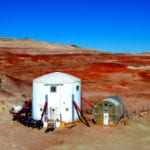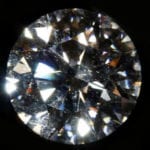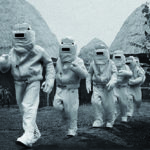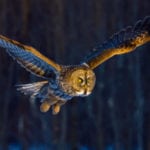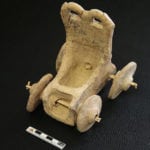 Weird Stuff
Weird Stuff  Weird Stuff
Weird Stuff  Animals
Animals 10 Inspiring Tales of Horses Being Human
 Mysteries
Mysteries Top 10 Haunting Facts About the Ghost Ship MV Alta
 History
History 10 Surprising Stories About the Texas Rangers
 Humans
Humans 10 Philosophers Who Were Driven Mad by Their Own Theories
 Miscellaneous
Miscellaneous 10 Video-Game-Worthy Weapons and Armors from History
 Weird Stuff
Weird Stuff 10 Psychics Who Accurately Predicted Wartime Events
 The Arts
The Arts 10 Pieces of Art Inspired by a Broken Heart
 Health
Health 10 Science Fiction-Sounding New Medical Treatments
 History
History 10 Surprising Facts About the Father of Submarine Warfare
 Weird Stuff
Weird Stuff 10 Times Real Laws Were Based on Bizarre Hypotheticals
 Animals
Animals 10 Inspiring Tales of Horses Being Human
 Mysteries
Mysteries Top 10 Haunting Facts About the Ghost Ship MV Alta
Who's Behind Listverse?

Jamie Frater
Head Editor
Jamie founded Listverse due to an insatiable desire to share fascinating, obscure, and bizarre facts. He has been a guest speaker on numerous national radio and television stations and is a five time published author.
More About Us History
History 10 Surprising Stories About the Texas Rangers
 Humans
Humans 10 Philosophers Who Were Driven Mad by Their Own Theories
 Miscellaneous
Miscellaneous 10 Video-Game-Worthy Weapons and Armors from History
 Weird Stuff
Weird Stuff 10 Psychics Who Accurately Predicted Wartime Events
 The Arts
The Arts 10 Pieces of Art Inspired by a Broken Heart
 Health
Health 10 Science Fiction-Sounding New Medical Treatments
 History
History 10 Surprising Facts About the Father of Submarine Warfare
10 Amazing Things We Learned From The Comet We Conquered
The Rosetta Spacecraft is an absolute marvel. Commissioned and launched by the European Space Agency (ESA), the plucky probe has completed the most amazing journey of any manmade object.
Philae’s touchdown on comet Churyumov-Gerasimenko was the culmination of over 40 years of planning and 10 years of perfectly choreographed yet still incredibly tense space-travel. The craft flew around the Earth three times, rounded Mars once, hibernated for 31 months, and eventually alighted on a 4-kilometer-wide (2.5 mi) rock that shoots through space at speeds of up to 135,000 kilometers (83,000 mi) per hour. Superheroes exist, and they work at the ESA.
10CG Shows Jupiter In Action
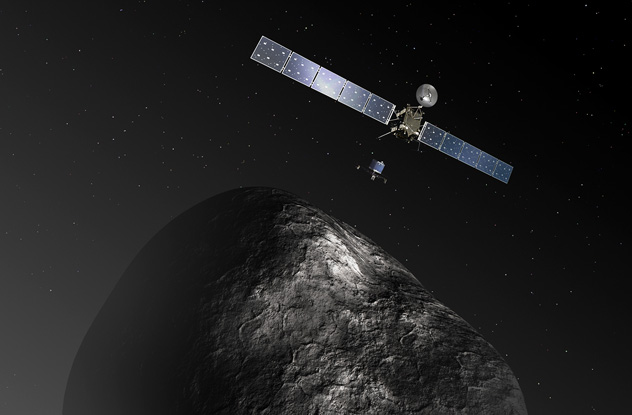
Jupiter is a giant planet, and its gravitational influence hits the whole solar system. The gas giant constantly perturbs the orbits of comets, sending them hurtling toward the Sun, out into space, or sometimes even at us.
The Kuiper Belt, a large assemblage of icy rocks past Neptune, provides Jupiter with plenty of ammo. It’s believed that Churyumov-Gerasimenko originated within this belt, so CG and its brethren are known as Jupiter Family comets. These short-period comets have orbital periods of about 20 years (CG’s orbital period is 6.6 years). And they make regular forays to the inner solar system, making them perfect targets for exploration.
The glut of comets within the solar system makes them somewhat interchangeable, and the current CG mission is actually a backup plan. Rosetta was meant to rendezvous with a similar comet called 46/P Wirtanen, yet program delays forced a change of plans as Wirtanen sped by.
And while we’ve known that Jupiter loves bullying little guys, comet CG has allowed us to see it happen in unprecedented detail. Hanging out far from the Sun, CG remained frigidly inert and therefore invisible to us. But its flight plan was heavily altered by Jupiter’s pull, and it’s been sent uncomfortably close to the Sun. Over the coming months, it will start evaporating as it reaches perihelion.
9The Comet Is Singing
Creepy happenings are afoot on Churyumov-Gerasimenko. As Rosetta approached CG in August for its inaugural meet-and-greet, its magnetometer picked up a cacophony of odd noises emanating from the comet. Past the limit of human hearing, a range of instruments known as the Rosetta Plasma Consortium measured the discordance at a frequency of 40–50 mHz.
Astronomers were pleasantly surprised by CG’s song, since they did not expect to find the comet belting out tunes. The exact cause is still unclear, though it appears to be the result of magnetic interactions between the comet, gas, and the Sun.
First, the vaporized ice streaming from the comet becomes ionized by UV radiation from the Sun. The ionized cloud, now full of charged particles, forms a barrier against the shower of radioactive Sun-shrapnel that is the solar wind. These oscillations, caused by magnetic and electrical friction within the comet’s almost nonexistent atmosphere, could be causing the weird noises observed by Rosetta.
8The Longest Jump Ever
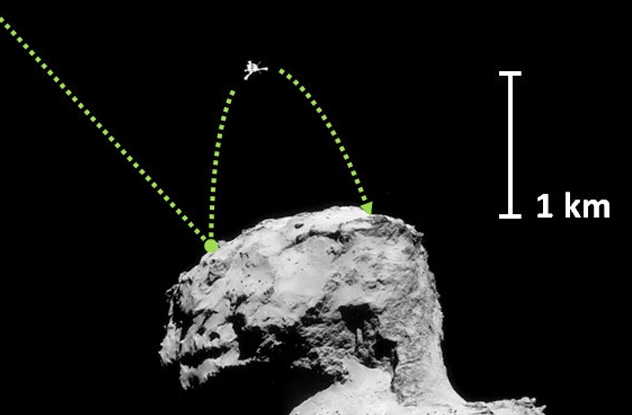
Thanks to a partially botched landing and the gravitational shortcomings of tiny CG, the Philae lander has completed the longest, slowest jump in history. Failing to harpoon itself into place after kissing the surface, it bounced off the comet almost back out into space, narrowly avoiding the harshest of fates after its historic 10-year journey around the inner planets.
On the bright side, Philae managed to get some major air—bouncing up to 1 kilometer (0.6 mi) from the surface, or about 25 percent of the comet’s length. This leap was followed by a second, smaller jump before the lander finally came to rest within a shadowy region at the foot of a rocky outcropping. Governed by CG’s weak gravity, Philae was stuck in this involuntary transit for almost two hours before settling for good.
Regardless of what may have seemed a catastrophic complication, Philae’s instruments did not incur any significant damage, and the lander completed about 90 percent of its mission goals. If anything, the unplanned jump was a blessing in disguise.
First, astronomers were able to witness a plume of dust stirred up by the impact. This gained us additional data on surface composition.
Furthermore, the jump may have ensured Philae’s long-term survival. Had it landed nominally and secured itself at the intended site, constant solar exposure could have fried its circuits over the course of many months. However, having come to rest in shadow, it might be able to draw on just enough solar energy to revive itself as the comet draws closer to the Sun, possibly by spring of 2015. And since Philae only needs the equivalent of several AA batteries worth of juice to power itself up again, we have every reason to remain optimistic.
7Huge Cliffs
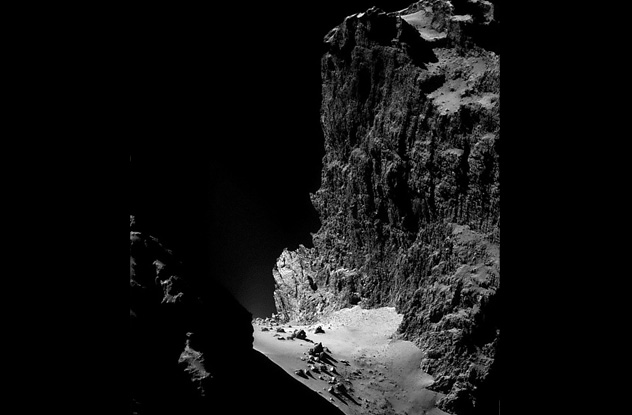
CG has some gigantic cliffs. As mentioned previously, CG is only a couple miles strong in length and width, so the 1-kilometer-high (0.6 mi) cliff in Rosetta’s crosshairs is about a quarter the size of the entire comet. For comparison, imagine terrestrial mountain ranges reaching thousands of miles into space, and consider that Everest is relatively unremarkable at only 29 kilometers (5.5 mi) high.
Noticing the majestic peaks while perusing images released by the ESA, amateur astronomer Stuart Atkinson cropped a picture of CG’s mountainous features to highlight a sheer, vertigo-inducing cliff face as impressive as any polychromatic nebular cloud. And NASA duly agreed, rewarding Atkinson’s hard work with Astronomy Picture of the Day honors on December 23.
The original snapshot is a composite of four different images taken from Rosetta’s NAVCAM from a distance of 20 kilometers (12 mi). After zooming in and a bit of crop-work, Atkinson has isolated the cliff in all its rugged glory, seemingly made larger by the contrast against a starless black.
The collection of boulders at the cliff’s foot is equally impressive. They’re also proportionately massive, as some of the stones are over 18 meters (60 ft) across, though only lightly anchored by weak gravity and weighing much less than one would imagine. As a matter of fact, you could leap from that kilometer-tall cliff and land safely at the bottom with nary a sprained ankle.
6It Looks Like A Duck
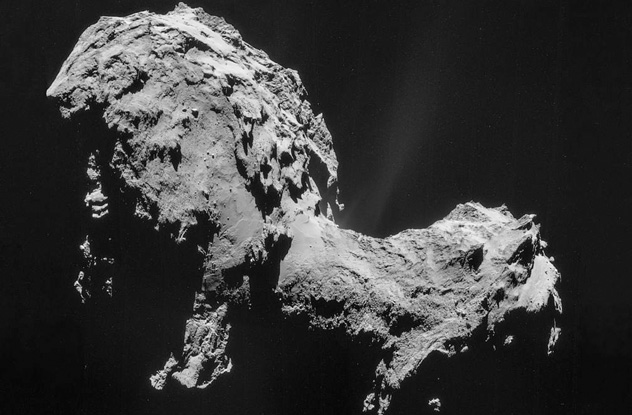
We don’t know why the comet looks like a rubber duck. And it might seem hard to believe, but astronomers didn’t even know what CG looked like until a month prior to touchdown on said comet. So imagine mission control’s surprise as they saw a blurry rubber duck staring back at them in July, when Rosetta finally got close enough to snap some pictures of its arranged mate.
Much better than finding a round, boring comet, CG’s double-lobed configuration gives astronomers many more things to ponder. For instance, how did it form? It’s uncertain, but here are some likely scenarios.
First, an anticlimactic, low-velocity impact saw two comets molded into one lumpy super-comet. Or, it’s possible that CG was an unimaginatively round comet and the gravitational pull from some immense body (like Jupiter) warped it out of shape. Or maybe CG was a larger chunk of ice, and most of it was lost into space, leaving an oddly shaped core. Further analysis will hopefully reveal whether CG is a single distorted body or a mishmash of cosmic debris.
5On The Origin Of Earth’s Water
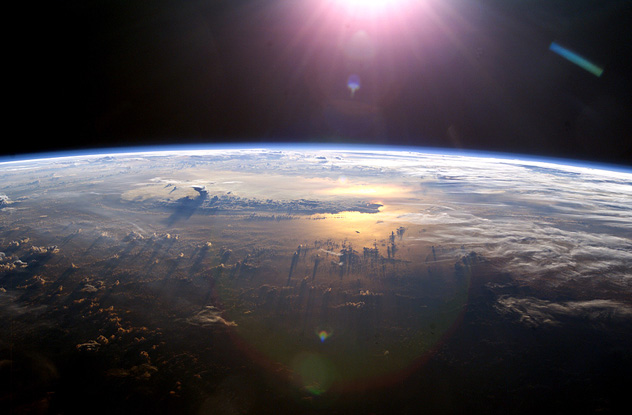
It’s believed that comet CG is a primordial leftover from the gigantic debris field that eventually coalesced into the Sun, planets, and us. So it offers a chemical snapshot of the far-flung past, and its constituent materials are clues to the composition of the proto–solar system.
CG also contains frozen water, which can help us answer longstanding questions on the origin of water on Earth. Through mass spectrometry, astronomers can peer into celestial bodies to ascertain their chemical components, and many comets and asteroids have been subjected to this treatment.
There are several types of hydrogen—other than normal hydrogen, there exists deuterium, a heavy hydrogen isotope with an extra neutron. And by analyzing the ratio between the two (the D/H ratio) astronomers can pinpoint the origin of the sampled water.
The water present on comet CG does not match the stuff on Earth. Quite surprisingly, neither does the slush found on most other comets. Only 1 out of a total of 11 comets analyzed held water similar to Earth’s. On the other hand, members from the asteroid belt were found to harbor Earth-water, though in tiny quantities. This suggests that the Jupiter Family Comets (and comets in general) are not responsible for Earth’s water content. It’s also possible that CG might have a more exotic origin than we thought.
4CG Smells Horrible
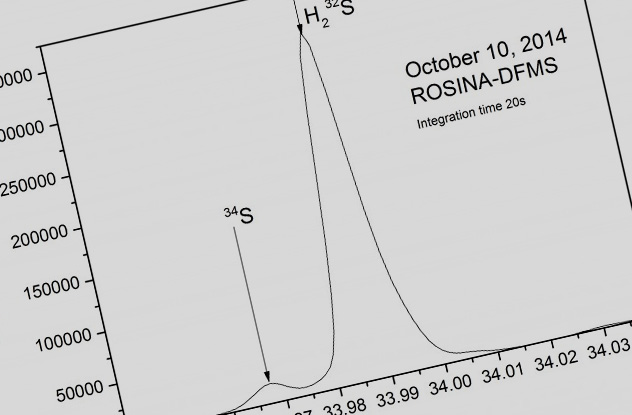
Most of our senses are useless in space, so we rarely stop to wonder what planets and comets smell like. But now Rosetta can answer at least one of those questions after using its two mass spectrometers as a smelloscope to sniff out the cloak of gases surrounding Churyumov-Gerasimenko’s nucleus.
Saying that comet CG smells like garbage would be a compliment—the gases seeping from CG offer a bouquet of almost every fundamental stench known to man. Hydrogen sulfide gives CG the tint of rotten eggs. Formaldehyde adds the smell of death. Methane and ammonia combine for the dual odors of cat pee and horse excreta. Sulfur dioxide gives the comet a tangy vinegar odor, and several other assorted compounds also contribute to the overall essence of filth.
ESA was somewhat surprised by the findings. At CG’s present distance from the Sun, it was believed that only carbon monoxide and carbon dioxide would be released as everything else would remain frozen until perihelion draws near. Other than disgusting us, CG’s scent signature (observed through spectral analysis) could offer clues to the comet’s origin.
3The Surprising Color
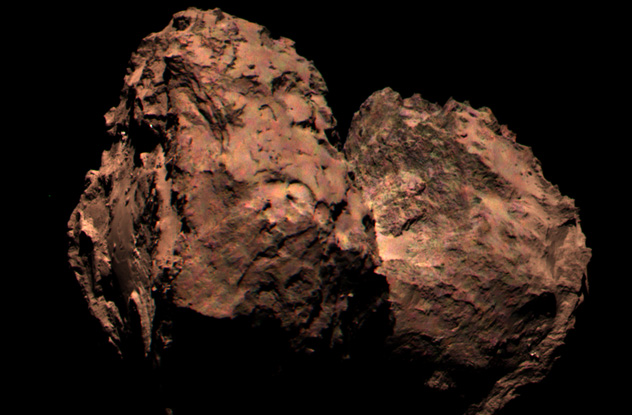
Churyumov-Gerasimenko might appear a pale, dusty gray in most images, but that’s just an illusion. The image shown above is a “true color” rendering of the comet in all its reddish-brown glory. But wait—that’s also illusory, since CG would not appear anywhere near that bright and colorful to anyone within its immediate vicinity.
The maroon-tint would only be visible if the comet was illuminated by pure, white light. In reality, it’s just a dark smudge against a darker backdrop of empty space, until it draws closer to the Sun and grows a tail as it sheds its layers. Right now, the tail-less, inert comet is nigh-invisible.
However, recently released photos from OSIRIS, Rosetta’s main imager, show the comet in its full monochromatic glory. The snapshot was produced by merging three images taken using red, green, and blue filters. The result is one of the grayest things we’ve ever seen and features almost no color variation on its surface. Like other comets in its family, CG is deeply dark—nearly as black as coal according to Holger Sierks, OSIRIS’s Principal Investigator.
In spite of all the data collected on Churyumov-Gerasimenko, a large chunk of it remains a mystery. Even though Rosetta arrived at the comet in August, its southern hemisphere is still uncharted and will most likely remain that way until it gets much closer to the Sun. It might seem unlikely, but the comet’s rotational axis is tilted in relation to its orbital plane, and so the south pole has been in constant darkness for months.
Rosetta has managed to get a shot of the comet’s blacked-out side, though only from backscattered light dancing off dust particles streaming from the comet. The sparse sunlight reveals a tiny portion of the comet’s dark side, though landscapes are indistinguishable. ESA believes this hidden side to be the most interesting as it’s been heavily shaped by the comet’s activity.
2Tougher Than We Thought
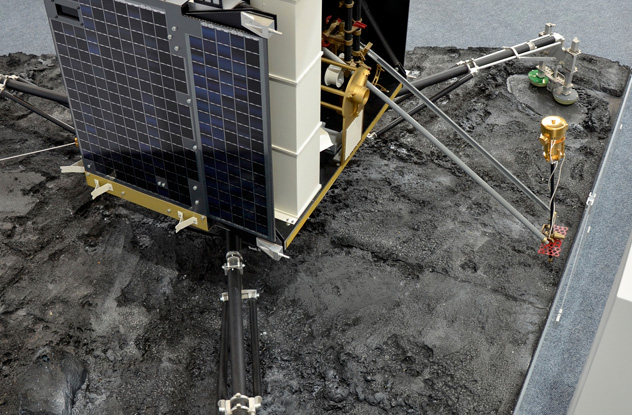
ESA’s Philae lander is equipped to get dirty. The very exciting SD2 system is responsible for puncturing the comet’s hide and distributing the samples to the suite of built-in chemistry labs and 20-plus ovens. Using a drill 100 times more efficient than the one at your house to bore up to 23 centimeters (9 in) into the crust, it would hopefully yield a pristine sample of comet material.
Sadly, because Philae experienced a rough landing and ended up in the wrong place, the drilling didn’t go as well as ESA had hoped. The operation was almost scrapped because of Philae’s precarious position. With one leg up in the air like a dog marking a tree, it was possible that activating the drill could push it into an even worse position.
But the drilling did commence, and according to a report from the German Aerospace Center (DLR) the comet was “a tough nut to crack.” It’s not yet clear whether the drill was able to return a viable sample, though organic molecules were detected circulating in CG’s whisper-thin atmosphere.
However, the procedure is still far from a failure as it produced a few surprising results, including the resiliency of the crust, since ESA expected soft, fluffy ground. The comet was also found to be rich in water content, with loads of ice locked up within its confines, as opposed to a frozen, gas-heavy mixture.
1It Imaged Two Asteroids As Well

On its 10-year journey to comet Churyumov-Gerasimenko, the Rosetta spacecraft ran into a couple of cosmic stragglers. On September 5, 2008, it flew by asteroid Steins and captured a snapshot of the several-mile-wide body. Steins shows many signs of past impacts and features a crater that covers almost half of its surface. It’s so incredibly shiny it is referred to as “a diamond in the sky.”
On July 10, 2010, asteroid Lutetia (pictured above) buzzed past the probe at a distance of almost 3,200 kilometers (2,000 mi). Lutetia is over 100 kilometers (60 mi) in diameter and pock-marked with craters. The highly scarred landscape suggests Lutetia is over 3.4 billion years old and could be a leftover piece from the birth of our solar system. Lutetia also hosts hundreds of odd grooves on its surface, features that had only been previously spotted on Mars’s satellite Phobos, as well as on two other asteroids.
